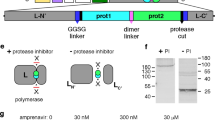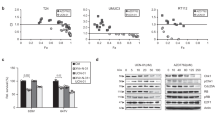Abstract
Acyclovir (9-[2-hydroxyethoxymethyl]guanine or ACV) is a nucleoside analogue with considerable potential for the treatment of herpes simplex virus (HSV) infections in man1,2. Two virus-coded enzymes are important in the mechanism of action of this drug: thymidine kinase (TK) which initiates its activation by converting it to the monophosphate3 and DNA polymerase whose action is inhibited by ACV triphosphate4. Changes in either gene may confer resistance5–7, but all reported mutations in the TK gene have resulted in failure of the resistant virus to induce appreciable levels of the enzyme. Such TK− mutants arise readily in tissue culture systems8,9 where the enzyme is non-essential for virus replication10, but in animals they show considerably reduced pathogenicity and neurovirulence7,11–14. We now describe the isolation of a resistant mutant which induces a TK of altered substrate specificity and we show that this virus retains pathogenicity for mice with only a slight attenuation of neurovirulence.
This is a preview of subscription content, access via your institution
Access options
Subscribe to this journal
Receive 51 print issues and online access
$199.00 per year
only $3.90 per issue
Buy this article
- Purchase on Springer Link
- Instant access to full article PDF
Prices may be subject to local taxes which are calculated during checkout
Similar content being viewed by others
References
Elion, G. B. et al. Proc. natn. Acad. Sci. U.S.A. 74, 5716–5720 (1977).
Schaeffer, H. J. et al. Nature 272, 583–585 (1978).
Fyfe, J. A., Keller, P. M., Furman, P. A., Miller, R. L. & Elion, G. B. J. biol. Chem. 253, 8721–8727 (1978).
Furman, P. A. et al. J. Virol. 32, 72–77 (1979).
Coen, D. M. & Schaffer, P. A. Proc. natn. Acad. Sci. U.S.A. 77, 2265–2269 (1980).
Schnipper, L. E. & Crumpacker, C. S. Proc. natn. Acad. Sci. U.S.A. 77, 2270–2273 (1980).
Field, H. J. & Darby, G. Antimicrob. Ag. Chemother. 17, 209–216 (1980).
Field, H. J., Darby, G. & Wildy, P. J. gen. Virol. 49, 115–124 (1980).
Smith, K. O., Kennell, W. L., Poirier, R. H. & Lynd, F. T. Antimicrob. Ag. Chemother. 17, 144–150 (1980).
Dubbs, D. R. & Kit, S. Virology 22, 439–502 (1964).
Field, H. J. & Wildy, P. J. Hyg., Camb. 81, 267–277 (1978).
Tenser, R. B. & Dunstan, M. E. Virology 99, 417–422 (1979).
Tenser, R. B., Miller, R. L. & Rapp, F. Science 205, 915–917 (1979).
Klein, R. J., De Stephano, E., Brady, E. & Friedman-Kien, A. E. Arch. Virol. (in the press).
Jamieson, A. T., Gentry, G. A. & Subak-Sharpe, J. H. J. gen. Virol. 24, 465–480 (1974).
Darby, G., Larder, B. A., Bastow, K. F. & Field, H. J. J. gen. Virol. 48, 451–454 (1980).
Field, H. J., Bell, S. E., Elion, H. B., Nash, A. A. & Wildy, P. Anitmicrob. Ag. Chemother. 15, 554–561 (1979).
Nash, A. A., Field, H. J. & Quartey-Papafio, R. J. gen. Virol. 48, 351–364 (1980).
Marcialis, M. A. et al. Experimenta 31, 502–503 (1975).
Field, H. J., McMillan, & Darby, G. J. inf. Dis. (in the press).
Hill, T. J., Field, H. J. & Blyth, W. A. J. gen. Virol. 28, 341–353 (1975).
Klemperer, H. G., Haynes, G. R., Shedden, W. I. H. & Watson, D. H. Virology 31, 502–503 (1967).
Minson, A. C., Wildy, P., Buchan, A. & Darby, G. Cell 13, 581–587 (1978).
Shelton, K. R. & Clark, J. M. Jr, Biochemistry 6, 2735–2739 (1967).
Author information
Authors and Affiliations
Rights and permissions
About this article
Cite this article
Darby, G., Field, H. & Salisbury, S. Altered substrate specificity of herpes simplex virus thymidine kinase confers acyclovir-resistance. Nature 289, 81–83 (1981). https://doi.org/10.1038/289081a0
Received:
Accepted:
Issue Date:
DOI: https://doi.org/10.1038/289081a0
This article is cited by
-
Esterase mutation is a mechanism of resistance to antimalarial compounds
Nature Communications (2017)
-
Predicting and preventing the emergence of antiviral drug resistance in HSV-2
Nature Medicine (1998)
-
Continuous infusion of acyclovir is more effective than discontinuous infusion for treatment of genital herpes in an immunocompromised patient
Infection (1994)
Comments
By submitting a comment you agree to abide by our Terms and Community Guidelines. If you find something abusive or that does not comply with our terms or guidelines please flag it as inappropriate.



